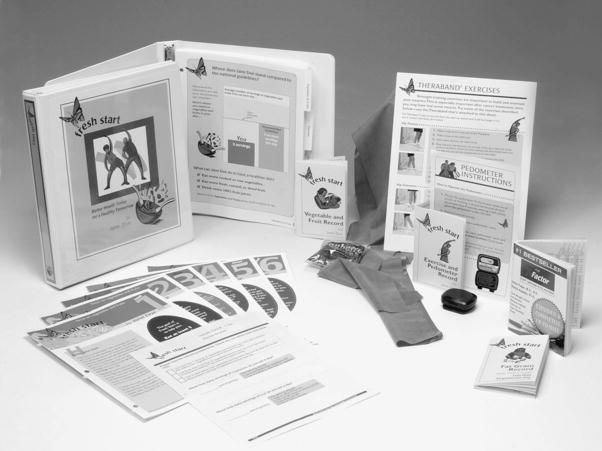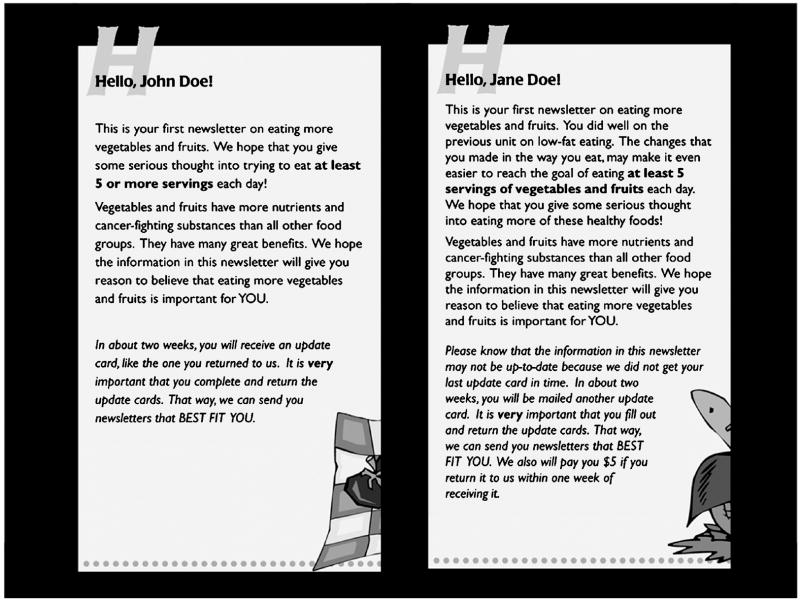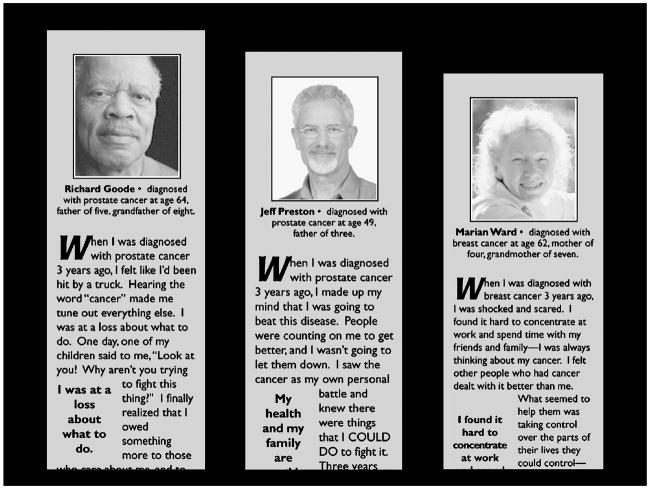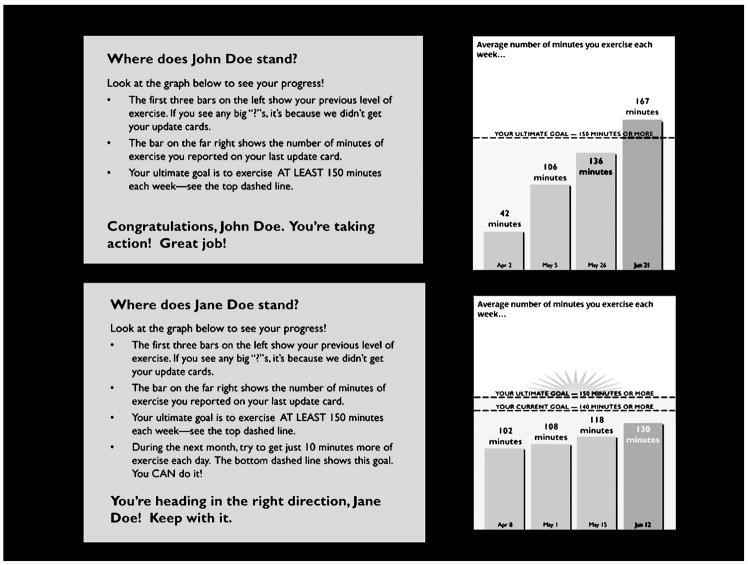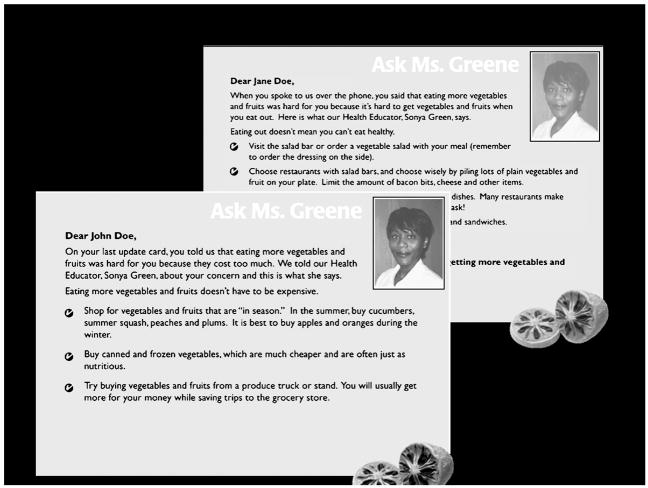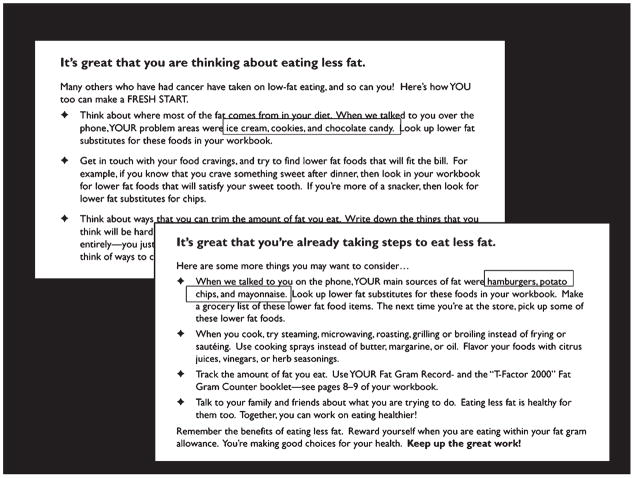Cancer Survivors—A Growing and Vulnerable Population
Only a few decades ago, the diagnosis of cancer was considered a virtual death sentence. Today, however, 5-year survival rates top 90% for many early-staged carcinomas.1 Consequently, there are burgeoning numbers of cancer survivors who currently comprise 3% to 4% of the US population.2 Although this is encouraging, cancer survivors, either because of late effects of treatment, genetic linkage, or common lifestyle behaviors, are at increased risk for second cancers, cardiovascular disease, diabetes, osteoporosis, and functional decline. These conditions place an enormous toll on the healthcare economy and are responsive to diet and exercise interventions.3,4
Although the cancer diagnosis may trigger a teachable moment for promoting healthful lifestyle change, many cancer survivors either fail to initiate changes in their dietary or exercise practices or are unsuccessful at sustaining them long-term.3,4 In a recent analysis of data from the Health Initiative Survey—2000, Bellizzi and colleagues4 found that although cancer survivors are somewhat more likely to adhere to physical activity guidelines, for the most part, their health behaviors parallel those of the general population—a population marked by inactivity; overweight and obesity; suboptimal fruit, vegetable, and fiber consumption; and high intakes of fat. Hence, there is a need for interventions that promote healthful lifestyle change in this vulnerable population.3,4
The good news is that previous surveys suggest that cancer survivors have high levels of interest in diet and exercise interventions.5,6 The not-so-good news is that there also exist considerable barriers for intervention delivery. Issues surrounding transportation present a major barrier to cancer survivors who tend to be elderly and geographically dispersed.5,6 Thus, clinic-based programs, successful in attracting patients with other chronic diseases, often fail to be well received by cancer survivors who also may have increased anxiety in reporting to institutions where they received their diagnoses and treatment. Past surveys suggest that cancer survivors prefer home-based interventions that are delivered via mailed print materials.5,6 The challenge lies in developing effective home-based interventions that are capable of changing lifestyle behaviors.
Cancer survivors are motivated to change lifestyles for the better, but they need help.
This article provides a detailed description of the FRESH START intervention, an intervention composed of a 10-month series of tailored mailed materials, which were found to significantly improve the dietary and exercise behaviors of 543 breast and prostate cancer survivors. Although this intervention has been briefly outlined in previous reports,7–9 this article will focus specifically on the FRESH START intervention and its conceptual framework and overall design.
Using Behavioral Theory as a Framework for Interventions
As with most effective interventions, we began the design of our project by carefully selecting appropriate and well-established theoretical models that offered a robust conceptual framework. We selected Bandura’s Social Cognitive Theory as our primary theoretical framework because its basic tenets of self-efficacy, self-monitoring, and incremental goal setting best fit our target population and the distance-medicine–based nature of this individually tailored intervention.10 In addition, we used elements from the Transtheoretical Model to frame our tailored messages in an effort to maximally engage participants and move them through various stages of change ranging from precontemplation (not thinking about changing their behavioral practices) to contemplation (beginning to think about changing their behaviors), preparation (getting ready to change their behaviors), action (actively undertaking behavioral change), and maintenance (maintaining healthful behavioral practices).11
Logistical Considerations and General Overview of the FRESH START Intervention
An illustration of the FRESH START intervention materials is featured in Figure 1. It was composed of a workbook and a series of newsletters that were tailored on information collected during the research study’s baseline interview. They were then iteratively tailored using information from brief interim surveys submitted by participants periodically throughout the intervention period ($5 incentives were provided to participants who returned their surveys within a 2-week period). The initial intervention materials were delivered at least 6 months postdiagnosis to allow participants time to complete their primary cancer treatment. A data management system was created to collect and track each subject’s behavioral information, as well as his or her status relative to the intervention.8 The parameters from this data management system dictated how the materials were tailored and when the materials were mailed. A second program was created to integrate an individual’s data with specific messages defining facets of behavior (e g, skill development, stage of readiness, and barriers) that were stored in an extensive message library. Thus, the FRESH START materials had a unified programmatic appearance, yet were individually tailored for each participant. Readers unfamiliar with the mechanics of tailoring are referred to the text, Tailoring Health Messages: Customizing Communication with Computer Technology,12 which defines tailoring as, “any combination of information or change strategies intended to reach one specific person, based on characteristics that are unique to that person, related to the outcome of interest, and that have been derived from an individual assessment.”
Figure 1.
FRESH START intervention materials.
Messages were tailored to each individual.
Participants taking part in the FRESH START trial received 2 of the following 3 possible modules aimed at promoting goal behavior consistent with the national guidelines (year 2000): (1) exercise (150+ min/wk), (2) dietary fat restriction (total fat <30% of kcal and saturated fat <10% of kcal), and (3) fruit and vegetable (F&V) consumption (5+ servings per day).13 Each module was delivered solely to participants who currently did not meet goal behavior in that particular domain. In keeping with the Social Cognitive Theory,10 module order was determined by self-efficacy score. In other words, the content area in which participants were most confident in changing was introduced first, with the hope that they would experience some level of mastery and then be able to generalize their success to then finally master the second module (also in keeping with the old adage first coined by Sir Arthur Helps in 1868, “Nothing succeeds like success.”).
The initial mailing consisted of a personalized workbook that included the first module and was followed by a series of 3 personally tailored newsletters spaced 6 to 7 weeks apart. Once the first module was completed, the second module was mailed and again it was followed by a series of 3 personally tailored newsletters. Each module also included personalized record logs to help participants track their behavior (to promote change and improve self-reporting accuracy). In addition, each module also included items that served as behavioral cues [ie, pedometers (Accusplit Eagle, San Jose, Calif) and Therabands (Hygenic Corp, Akron, Ohio) accompanied the exercise module, dried fruit samples were included in the F&V module, and a fat gram counter booklet (T-Factor 2000, WW Norton & Co, New York, 1999) and butter substitute samples (ie, Butterbuds or Molly McButter) accompanied the low-fat unit].
The FRESH START intervention is highly personalized.
FRESH START Personally Tailored Workbook
The workbook was personalized with the participant’s name appearing on the front cover and the initial pages of each module featured how the participants’ behaviors compared with national guidelines. Subsequent chapters of each module featured standardized text in large font and set at a 5th- to 7th-grade reading level.
FRESH START Personally Tailored Newsletters
Each newsletter was 4 pages in length and featured colorful graphics and easy-to-read text. All newsletters included the following sections: personalized greeting, goal statement, testimonial, advice column, “fun facts,” benefits of practicing healthful behaviors, progress report, goal setting, and closing message. The section on goal statements (reiteration of national guidelines, such as “exercise 30 minutes a day at least 5 days a week,” “eat at least 5 servings of F&V each day,” etc) was not tailored. Fun facts and benefits sections also were not tailored, but featured new information regarding the module topic with each newsletter. All other sections were personally tailored using information collected from the research study’s baseline survey, as well as data from brief interim surveys. A description of the tailoring methods follows.
Each newsletter began with a greeting section that welcomed each participant by name and provided them information regarding the sequence order of the newsletter. Figure 2 provides examples of how greeting messages differed with regard to name, sequence order, and whether or not interim surveys were received. The greeting also was tailored with regard to stage of readiness.11 In both of these examples, the messages target participants who were precontemplators, urging them to “give serious thought” toward eating more F&Vs. Participants found to be contemplators or preparers would have received much different messages such as, “It’s good to know that you’re seriously thinking about including more F&Vs in your diet. This newsletter will provide some easy steps on how to get started,” or “It’s great to know that you’ve already started to include more F&Vs in your diet—good for you! This newsletter will provide you with other easy ways to include even more F&Vs in your diet,” respectively. In composing the message library, which included thousands of messages for each behavior, care was taken to use new verbiage so that each newsletter would be viewed as fresh and unique.
Figure 2.
Examples of greeting messages from FRESH START–tailored newsletters.
Testimonials appeared on the second page of each newsletter and featured photographs and text of cancer survivor examples who were successful in changing their behaviors. Care was taken to match participants with examples that were similar in terms of basic demographic characteristics, such as age (ie, <60 vs ≥60 years old), race (ie, African American or other), and sex. In addition, participants were matched with examples of identical cancer coping style. According to Watson, cancer patients can be categorized (using the Mini-Mental Adjustment to Cancer subscale) into “fighting spirits,” “fatalists,” “cognitive avoiders,” “helpless/hopeless,” or “anxious preoccupiers.”13,14 These efforts were undertaken to motivate participants by providing examples of people, similar to them, who were successful in changing their behaviors. Figure 3 provides examples of testimonials provided to an older African American prostate cancer survivor exhibiting a helpless/hopeless coping style (left column), a younger white prostate cancer survivor manifesting a fighting spirit coping style (middle column), and an older white breast cancer survivor demonstrating an anxious preoccupation coping style (right column). Note that for the duration of the intervention, the participant received newsletters that consistently featured the same person as the testimonial example—a rationale that borrows elements from role modeling, the buddy system, and patient navigator programs.10,15–17
Figure 3.
Examples of testimonial messages from FRESH START–tailored newsletters.
Cancer patients were categorized by their coping styles into fighting spirits, fatalists, cognitive avoiders, helpless/hopeless, or anxious preoccupiers.
A progress report also was included on the second page, which featured a graph depicting the participant’s behavior in relation to goal from the time of enrollment until the most recent interim survey. Personalized messages accompanied the graph using the following strategy: praise for achievement of goals, praise and encouragement for progress toward goal, encouragement for lack of progress, and encouragement to submit updated data for those who failed to submit interim surveys. Figure 4 provides 2 examples of progress reports, one to a participant who achieved goal behavior (top) and another to one who was making positive changes but who had yet to achieve goal (bottom).
Figure 4.
Examples of progress report messages from FRESH START–tailored newsletters.
Strategies to overcome barriers were provided on the third page using an advice column format. This section was personally tailored on each participants’ barriers that were reported at the time of the baseline interview. In composing the message library, distinct advice columns were written to address each barrier and these were rotated throughout the series of newsletters to make sure that participants received a new advice column with each newsletter. Given the slight possibility that participants would report no barriers, messages were written for motivating behavior change in the absence of any barriers. In this case, 3 different advice columns for each of the 3 behaviors (exercise, F&V intake, and dietary fat restriction) were created. This scenario illustrates some of the forethought needed in developing an automated intervention, which must account for any possible response, or lack thereof. Figure 5 provides examples of 2 different advice columns used in the F&V module; the top example shows an advice column provided to a participant who reported barriers to eating F&Vs when they eat out at restaurants, whereas the bottom example was provided to a participant who reported that cost is their barrier to eating more F&Vs.
Figure 5.
Examples of overcoming barriers messages from FRESH START–tailored newsletters.
Messages were also tailored on stages of readiness.
Participants in contemplation or preparation/action stages of readiness also received a section in their newsletter devoted to making concrete improvements in their lifestyle behaviors.11 Much of the data used to tailor this section came from the baseline survey. Examples from 2 newsletters within the low-fat module are featured in Figure 6. The top example came from the newsletter of a participant who was classified as a contemplator (hence, the message, “It’s great you’re thinking about eating less fat.”) and whose major sources of dietary fat (from the National Cancer Institute’s Diet History Questionnaire administered during the baseline survey)18–20 included ice cream, cookies, and chocolate candy. The bottom example came from the newsletter of a participant who was classified in the preparation or action stages of change (hence, the message, “It’s great that you’re already taking steps to eat less fat”) and whose major sources of dietary fat included hamburgers, potato chips, and mayonnaise. Participants classified as precontemplators did not receive this section in their newsletters because according to the Transtheoretical Model,11 it is futile, or perhaps even counterproductive, to provide detailed information to individuals who are not ready to receive it. Thus, newsletters for precontemplators featured colorful graphics in place of such a text message.
Figure 6.
Examples of enabling goal-setting messages from FRESH START–tailored newsletters.
The last page of each newsletter also was tailored on stage of readiness.11 Closing messages reiterated the benefits of practicing healthy behaviors and provided encouragement to complete future interim surveys. As with all sections, efforts were made to craft messages using new verbiage so that messages remained fresh and novel. In accordance with the Transtheoretical Model,11 any messages prepared for precontemplators were much shorter, less detailed, and punchier than messages for contemplators, whereas participants in preparation/action received messages that were the most lengthy and complex.
As reported at the 2006 meetings of the American Society of Clinical Oncology,9 the FRESH START intervention has been highly successful in changing the lifestyle behaviors of cancer survivors, and a significantly higher proportion of those who received the tailored intervention achieved goal behavior after completion of the 10-month intervention than those in the attention control group.21 Therefore, such an intervention could be adapted to promote other healthful behaviors that are just as critical among cancer survivors, such as weight management.3,4,13 Furthermore, although cancer survivors represent a unique patient population, such interventions also hold promise for controlling other diseases, such as cardiovascular disease, hypertension, and diabetes. Indeed, with escalating healthcare costs and the economic drain posed by the energy crisis, the need for effective home-based interventions is more critical than ever. In going forward, more research is necessary to determine if the complexity of tailored messaging used in the FRESH START intervention is truly necessary or if scaled-down models would work just as effectively. In addition, there also is considerable cost associated with implementing a mailed material intervention ($800 per capita, which includes costs associated with development, delivery, and collection of data [via mail and telephone survey] for tailoring the intervention)— costs that could be minimized if such programs could be adapted to Web-based formats. Although previous surveys among various populations of cancer survivors suggest a consistent preference for mailed material interventions,5,6 currently, it is unknown how Web-based interventions perform in comparison to mailed material formats. Certainly, all of these represent areas where nutritionists can make key contributions in moving the field of health education forward.
Acknowledgments
This article focuses on experiences gained from the FRESH START Trial, an NIH-funded (R01 CA81191 and M01-RR-30) randomized controlled trial aimed at improving the diet and exercise behaviors of 543 newly diagnosed breast and prostate cancer survivors. Funding sources for this trial also included the Susan G. Komen Foundation and the American Institute of Cancer Research.
References
- 1.American Cancer Society. Cancer Facts & Figures—2007. [Accessed May 1, 2007];American Cancer Society. 2007 Available at: http://www.cancer.org/downloads/STT/CAF2007PWSecured.pdf.
- 2.Rowland J, Mariotto A, Aziz N, et al. Cancer survivorship—United States. MMWR. 2004;53:526–529. [PubMed] [Google Scholar]
- 3.Demark-Wahnefried W, Aziz NM, Rowland JH, et al. Riding the crest of the teachable moment: promoting long-term health after the diagnosis of cancer. J Clin Oncol. 2005;23:5814–5830. doi: 10.1200/JCO.2005.01.230. [DOI] [PMC free article] [PubMed] [Google Scholar]
- 4.Bellizzi KM, Rowland JH, Jeffery DD, et al. Health behaviors of cancer survivors: examining opportunities for cancer control intervention. J Clin Oncol. 2005;23:8884–8893. doi: 10.1200/JCO.2005.02.2343. [DOI] [PubMed] [Google Scholar]
- 5.Demark-Wahnefried W, Peterson B, McBride C, et al. Current health behaviors and readiness to pursue life-style changes among men and women diagnosed with early stage prostate and breast carcinomas. Cancer. 2000;88:674–684. [PubMed] [Google Scholar]
- 6.Demark-Wahnefried W, Werner C, Clipp EC, et al. Survivors of childhood cancer and their guardians. Cancer. 2005;103:2171–2180. doi: 10.1002/cncr.21009. [DOI] [PubMed] [Google Scholar]
- 7.Demark-Wahnefried W, Clipp EC, McBride C, et al. Design of FRESH START: a randomized trial of exercise and diet among cancer survivors. Med Sci Sports Exerc. 2005;35:415–424. doi: 10.1249/01.MSS.0000053704.28156.0F. [DOI] [PubMed] [Google Scholar]
- 8.Macri JM, Downs SM, Algoti S, et al. A simplified approach to generating tailored questionnaires, health education messages and guideline recommendations. J Am Med Inform Assoc. 2005;23:316–321. doi: 10.1097/00024665-200511000-00007. [DOI] [PMC free article] [PubMed] [Google Scholar]
- 9.Demark-Wahnefried W, Clipp E, Lipkus I, et al. Results from FRESH START: a randomized controlled trial to improve diet and exercise behaviors among breast or prostate cancer survivors. J Clin Oncol. 2006;24:468s. (abstr 8503) [Google Scholar]
- 10.Bandura A. Self-efficacy: toward a unifying theory of behavioral change. Psychol Rev. 1977;84:191–215. doi: 10.1037//0033-295x.84.2.191. [DOI] [PubMed] [Google Scholar]
- 11.Prochaska JO, Velicer WF, Rossi JS, et al. Stages of change and decisional balance for 12 problem behaviors. Health Psychol. 1994;13:39–46. doi: 10.1037//0278-6133.13.1.39. [DOI] [PubMed] [Google Scholar]
- 12.Kreuter M, Farrell D, Olevitch L, et al., editors. Tailoring Health Messages: Customizing Communication with Computer Technology. Mahwah, NJ: Lawrence Erlbaum Assoc; 2000. [Google Scholar]
- 13.Brown JK, Byers T, Doyle C, et al. Nutrition and physical activity during and after cancer treatment: an American Cancer Society guide for informed choices. CA Cancer J Clin. 2003;53:268–291. doi: 10.3322/canjclin.53.5.268. [DOI] [PubMed] [Google Scholar]
- 14.Watson M, Greer S, Young J. Development of a questionnaires measure of adjustment to cancer: the MAC scale. Psychol Med. 1988;18:203–209. doi: 10.1017/s0033291700002026. [DOI] [PubMed] [Google Scholar]
- 15.Watson M, Law M, dos Santos M, et al. The Mini-MAC further development of the Mental Adjustment to Cancer scale. J Psychosoc Oncol. 1994;12:33–45. [Google Scholar]
- 16.Mayo RM, Sherrill WW, Crew L, Watt P, Mayo WW. Connecting rural African American and Hispanic women to cancer education and screening: the Avon Health Connector project. J Cancer Educ. 2004;19:123–126. doi: 10.1207/s15430154jce1902_14. [DOI] [PubMed] [Google Scholar]
- 17.Rogers D, Petereit DG. Cancer disparities research partnership in Lakota Country: clinical trials, patient services, and community education for the Oglala, Rosebud, and Cheyenne River Sioux tribes. Am J Public Health. 2005;95:2129–2132. doi: 10.2105/AJPH.2004.053645. [DOI] [PMC free article] [PubMed] [Google Scholar]
- 18.Anonymous Increasing physical activity. A report on recommendations of the Task Force on Community Preventive Services. MMWR. 2001;50:1–14. [PubMed] [Google Scholar]
- 19. [Accessed May 1, 2007];Diet History Questionnaire. Available at: http://riskfactor.cancer.gov/DHQ.
- 20.Subar AF, Thompson FE, Kipnis V, et al. Comparative validation of the Block, Willett, and National Cancer Institute food frequency questionnaires. Am J Epidemiol. 2001;154:1089–1099. doi: 10.1093/aje/154.12.1089. [DOI] [PubMed] [Google Scholar]
- 21.Denmark-Wahnefried W, Clipp EC, Lipkus IM, et al. Main outcomes of the FRESH START trial: a sequentially-tailored diet and exercise mailed print intervention among breast and prostate cancer survivors. J Clin Oncol. doi: 10.1200/JCO.2007.10.7094. In press. [DOI] [PubMed] [Google Scholar]



